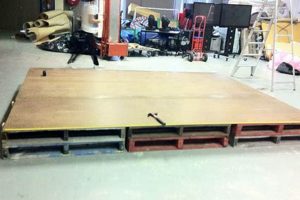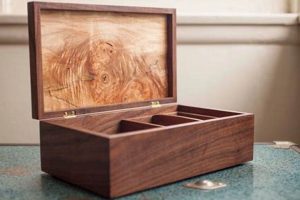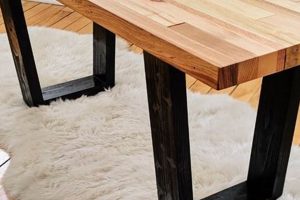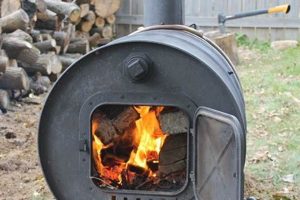Constructing a self-made wooden structure to frame the matrimonial ceremony presents a personalized approach to wedding dcor. This handcrafted element serves as a focal point, visually defining the space where vows are exchanged. For instance, a couple might build an arch from reclaimed lumber, adorning it with flowers that complement the wedding’s color palette.
The appeal of creating such a structure lies in its cost-effectiveness and the opportunity for deep personalization. It allows couples to inject their unique aesthetic into the event, creating a memorable and bespoke experience. Historically, arches have symbolized thresholds and transitions, making their presence at weddings particularly poignant, representing the couple’s journey into married life.
The following sections will delve into the practical aspects of designing and building a structure for a wedding, encompassing material selection, construction techniques, and decoration strategies to ensure a seamless integration with the overall wedding theme.
Crafting a Lasting Impression
The creation of a wooden structure for a wedding necessitates careful planning and execution. The subsequent guidance aims to provide practical insights for a successful endeavor.
Tip 1: Material Selection: Opt for wood appropriate for outdoor use, considering weather resistance and structural integrity. Cedar, redwood, or pressure-treated lumber are recommended. Proper sealing or staining will further enhance longevity.
Tip 2: Design Planning: Develop a detailed blueprint that accounts for dimensions, weight distribution, and aesthetic preferences. Consider the backdrop and surrounding environment to ensure visual harmony.
Tip 3: Secure Foundations: Ensure the base of the structure is stable and secure. Depending on the location, this may involve embedding the posts in concrete or using weighted bases to prevent tipping.
Tip 4: Joinery Techniques: Employ robust joinery methods, such as mortise and tenon or bolted connections, to ensure structural integrity. Consider the skill level and available tools when selecting a joinery technique.
Tip 5: Load Testing: Before decorating, test the structure’s ability to withstand anticipated weight from floral arrangements and other embellishments. This will help prevent collapse during the ceremony.
Tip 6: Decoration Considerations: Plan the method for attaching decorations, ensuring secure and damage-free application. Use non-damaging fasteners like zip ties or floral wire.
Tip 7: Transportation Planning: If constructed off-site, develop a comprehensive transportation plan, accounting for size, weight, and potential assembly/disassembly requirements. Secure the structure during transit to prevent damage.
By adhering to these recommendations, individuals can enhance the likelihood of constructing a safe, aesthetically pleasing, and memorable structure.
The final section will provide insights into stylistic integration, ensuring the structure complements the overall wedding theme and aesthetic.
1. Structural Integrity
Structural integrity is a non-negotiable prerequisite for any self-constructed wooden arch intended for use at a wedding. A failure in structural integrity can lead to catastrophic collapse, resulting in potential injury to individuals and disruption of the ceremony. The selection of appropriate materials and the employment of sound construction techniques are critical in ensuring the arch’s stability. For instance, using insufficiently sized lumber or improperly secured joints can compromise the structure’s load-bearing capacity, increasing the risk of failure under its own weight or external forces like wind.
The implementation of robust joinery methods, such as mortise and tenon or secure bolted connections, directly impacts the structural integrity of the arch. These techniques distribute weight evenly and resist shear forces, minimizing the likelihood of joint failure. Furthermore, the foundation upon which the arch rests must be stable and capable of supporting the structure’s weight, particularly on uneven or soft ground. The absence of a solid foundation can lead to instability and eventual collapse. A relevant case might involve a hastily constructed arch collapsing during the wedding ceremony due to wind, highlighting the direct correlation between deficient structural design and hazardous outcomes.
In summary, the structural integrity of a wooden arch intended for a wedding is paramount, directly impacting the safety and success of the event. Neglecting proper material selection, sound construction techniques, and stable foundations can result in structural failure, with potentially severe consequences. Prioritizing structural integrity is essential for ensuring a secure and aesthetically pleasing focal point for the ceremony.
2. Material Durability
Material durability stands as a cornerstone in the successful creation of a lasting structure. The longevity and stability of the wooden arch directly depend on the ability of the chosen wood to withstand environmental factors and physical stressors inherent in outdoor settings and repeated use.
- Resistance to Environmental Degradation
The selected wood must demonstrate resistance to decay, rot, and insect infestation. Softwoods such as pine are susceptible to these issues unless treated. Hardwoods like oak and redwood, possessing natural oils and denser structures, offer superior resistance. Untreated, a pine arch may show signs of decay within a year in humid climates, while a redwood arch could maintain structural integrity for several years under similar conditions. The consequence of failing to account for this factor is a structurally compromised arch that may require premature replacement or extensive repairs.
- Load-Bearing Capacity and Structural Stability
The wood’s inherent strength and ability to bear weight are crucial, especially when considering decorations. A softwood like cedar, while aesthetically pleasing, may not possess the necessary load-bearing capacity to support heavy floral arrangements without bending or cracking. Hardwoods, while more expensive, offer greater structural stability, ensuring the arch remains upright and secure. Choosing an inappropriate wood type can lead to structural failure, especially during inclement weather or if the arch is subjected to unexpected stresses.
- Dimensional Stability Under Varying Conditions
Wood is hygroscopic, meaning it absorbs and releases moisture depending on the surrounding environment. This absorption and release can cause swelling, shrinking, and warping, potentially compromising the arch’s structural integrity and aesthetic appearance. Seasoned lumber, properly dried before construction, exhibits greater dimensional stability. Ignoring this aspect can result in an arch that becomes unstable or visually unappealing as the wood reacts to changes in humidity and temperature.
- Resistance to Physical Damage
The wood should be resistant to dents, scratches, and other forms of physical damage that can occur during construction, transportation, and use. Softer woods are more prone to damage, while hardwoods offer greater resistance. A hardwood arch is likely to withstand the rigors of transportation and setup far better than an arch constructed from a less dense wood species. Choosing a durable wood helps maintain the arch’s appearance and structural integrity over time.
The facets discussed highlight the importance of informed material selection. The durability of wood chosen for a wedding dictates its capacity to withstand environmental and physical stressors, and thus maintain its appearance and structural integrity over the course of its lifespan. Choosing wisely is central to the outcome.
3. Aesthetic Harmony
Aesthetic harmony, in the context of a self-constructed wooden arch for a wedding, refers to the cohesive integration of the structure’s design, materials, and decorations with the overall stylistic theme and visual atmosphere of the event. It is the principle that ensures the arch does not appear as a discordant element but rather enhances the event’s visual appeal.
- Material Coherence
The type and finish of the wood employed should align with the wedding’s aesthetic. A rustic-themed wedding might benefit from reclaimed wood with a natural, weathered appearance, while a more formal event may call for smoothly finished hardwood with a polished stain. For example, using rough-hewn cedar for a modern, minimalist wedding would disrupt the intended aesthetic, creating visual dissonance.
- Proportionality and Scale
The dimensions of the arch must be proportionate to the surrounding venue and the individuals standing beneath it. An excessively large arch in a small space can overwhelm the setting, while an arch that is too small may appear insignificant. Consider a small backyard wedding: a towering arch would appear out of place, whereas a more modestly sized structure would complement the intimate setting.
- Decorative Integration
Floral arrangements, drapery, and other embellishments should be carefully selected to complement the arch’s inherent style and the wedding’s color palette. Mismatched or overly elaborate decorations can detract from the arch’s visual appeal and create a cluttered appearance. For instance, pairing delicate, pastel-colored flowers with a heavily textured, dark-stained arch might result in a visual conflict.
- Environmental Consistency
The arch should harmonize with the natural surroundings, particularly in outdoor settings. Consider the backdrop and existing landscape features when designing and decorating the arch. A beach wedding, for example, might benefit from an arch adorned with natural elements such as seashells and driftwood, blending seamlessly with the coastal environment.
The integration of these facets ensures that the self-constructed wooden arch is not merely a functional element but a carefully considered component of the wedding’s overall visual narrative. Achieving aesthetic harmony elevates the event, creating a more memorable and visually pleasing experience for all involved.
4. Budget Allocation
The creation of a self-made wooden structure for a wedding ceremony necessitates meticulous budget allocation. Financial planning is crucial to prevent cost overruns and ensure the project aligns with the overall financial constraints of the wedding. The correlation between careful budgeting and a successful construction hinges on the ability to procure quality materials without compromising the financial stability of other wedding-related expenses. For instance, neglecting to adequately budget for wood sealant may result in premature decay of the structure, leading to unforeseen replacement costs. Budget allocation acts as a controlling mechanism, ensuring that the envisioned arch becomes a tangible reality without incurring excessive debt or sacrificing other vital aspects of the celebration.
Practical application of budget allocation involves several key steps. Firstly, a detailed list of materials, including lumber, fasteners, stains, and decorative elements, must be compiled. Subsequently, price research from multiple vendors is essential to identify the most cost-effective options. A contingency fund, typically 10-15% of the total estimated cost, should be incorporated to account for unforeseen expenses or price fluctuations. An illustrative scenario involves a couple initially underestimating the cost of hardware, such as bolts and screws. Without a contingency, they might be forced to compromise on quality, potentially jeopardizing the structural integrity of the arch. Effective budget management also entails prioritizing essential items and making informed trade-offs. If the budget is constrained, simpler design features or less expensive decorative elements can be chosen without sacrificing the overall aesthetic appeal.
In summation, effective budget allocation is a critical determinant of success for those pursuing a self-constructed wooden arch for a wedding. It provides financial control, encourages responsible purchasing decisions, and mitigates the risk of exceeding financial limitations. While the appeal of a customized arch is undeniable, careful financial planning is paramount to ensure it complements, rather than compromises, the overall wedding budget. Overlooking this connection between budgetary constraints and project execution can lead to financial strain and ultimately detract from the celebratory nature of the event.
5. Timeline Management
Effective timeline management is crucial for the successful completion of a self-constructed wooden arch for a wedding. The project necessitates a structured schedule to ensure timely procurement of materials, construction, and decoration, thereby mitigating potential delays and ensuring the arch is ready for the wedding ceremony.
- Material Acquisition Scheduling
A designated timeframe for sourcing lumber, fasteners, stains, and decorative elements is paramount. Delays in material procurement can disrupt the entire project timeline. For instance, if a specific type of wood is back-ordered, construction will be postponed, potentially leading to schedule compression later in the process. Advance ordering and confirmation of delivery dates are essential.
- Construction Phase Allocation
The construction phase requires a realistic allocation of time, accounting for potential challenges such as weather conditions or unexpected complications in the assembly process. Setting daily or weekly goals, such as completing a specific section of the arch, provides tangible milestones and facilitates progress monitoring. Failure to accurately estimate construction time can lead to a rushed and potentially unstable final product.
- Decoration and Finishing Deadlines
A separate period must be allocated for decorating and finishing the arch, including staining, painting, and the attachment of floral arrangements or other embellishments. This phase often requires significant attention to detail and can be more time-consuming than initially anticipated. Rushing this phase may result in a visually unappealing or incomplete arch.
- Contingency Buffer Incorporation
A contingency buffer should be integrated into the timeline to accommodate unforeseen circumstances, such as illness, equipment malfunction, or adverse weather. This buffer provides flexibility and reduces the risk of the project falling behind schedule. Without a contingency plan, even minor delays can cascade and jeopardize the overall project timeline.
The integration of these facets into a cohesive timeline is crucial for realizing the vision of a self-constructed wooden arch for a wedding. Proactive planning and adherence to a well-defined schedule minimizes the risk of delays and ensures the timely completion of the project, thereby contributing to the overall success of the wedding ceremony.
6. Safety Protocols
The intersection of safety protocols and crafting a wooden structure for a wedding is defined by a direct cause-and-effect relationship: negligence in safety measures during the construction phase inevitably escalates the risk of personal injury. Woodworking, even on a small scale, involves the use of power tools, sharp instruments, and heavy materials, all of which present inherent hazards. Consequently, adherence to established safety guidelines becomes paramount. The absence of such adherence can lead to cuts, lacerations, eye injuries, or even more severe accidents involving power tools. For example, failure to utilize safety glasses while operating a saw can result in wood splinters or debris lodging in the eyes, causing significant harm. Similarly, neglecting to wear appropriate personal protective equipment (PPE), such as gloves and hearing protection, can increase the potential for long-term health issues stemming from prolonged exposure to noise and wood dust. Moreover, the structural integrity of the finished arch itself represents a safety concern. A poorly constructed arch, lacking secure joinery or stable foundations, poses a risk of collapse, potentially causing injury to wedding attendees. Therefore, prioritizing safety protocols is not merely an abstract concern; it is a fundamental component of constructing a reliable structure.
Practical application of safety protocols extends beyond individual actions during the build phase. It encompasses careful planning and risk assessment. Prior to commencing construction, a thorough evaluation of the workspace is essential to identify potential hazards, such as uneven surfaces or inadequate lighting. Ensuring the work area is well-lit and free of obstructions minimizes the risk of slips, trips, and falls. Moreover, proper ventilation is critical to mitigate the inhalation of wood dust and fumes from stains or sealants. Safe tool operation necessitates adherence to manufacturer guidelines and regular maintenance to ensure optimal performance. For instance, using a dull saw blade requires increased force, elevating the likelihood of kickback and subsequent injury. Moreover, the arch’s design should account for wind resistance and stability, particularly if the ceremony is to be held outdoors. A well-engineered design, coupled with robust construction techniques, minimizes the risk of structural failure due to environmental factors. A practical example includes the implementation of weighted bases to stabilize the arch on uneven terrain, thereby preventing accidental toppling.
In summation, the implementation of rigorous safety protocols is indispensable when crafting a self-constructed wooden arch for a wedding. It mitigates the risk of injury during the construction phase and ensures the structural integrity of the finished product, thereby safeguarding the well-being of wedding attendees. Overlooking safety protocols can have severe consequences, ranging from personal injury to project failure. Thus, it is incumbent upon those undertaking such projects to prioritize safety above all else, ensuring a celebratory occasion is not marred by preventable accidents. The adherence to safety guidelines represents not merely a best practice but a fundamental responsibility.
Frequently Asked Questions
The following addresses frequently encountered queries concerning the self-construction of a wooden arch for wedding ceremonies. The emphasis rests upon structural integrity, safety considerations, and regulatory compliance.
Question 1: What lumber types are structurally optimal for withstanding outdoor environmental conditions?
Optimal lumber choices prioritize resistance to moisture, decay, and insect infestation. Pressure-treated lumber, redwood, and cedar exhibit superior durability in outdoor settings compared to untreated softwoods such as pine. The selection should correspond with local climate conditions.
Question 2: What constitutes adequate stabilization for preventing arch collapse, especially in windy environments?
Stabilization strategies entail anchoring the arch to the ground through concrete footings, weighted bases, or stake systems. Load testing the structure prior to decoration is recommended to verify stability under anticipated wind loads.
Question 3: What are the necessary safety precautions during the construction phase when utilizing power tools?
Mandatory safety precautions include the consistent use of eye protection, hearing protection, and gloves. Power tools must be operated according to manufacturer specifications, with regular inspections for proper functioning. A clear and unobstructed workspace is essential.
Question 4: How should the wooden arch be transported to the wedding venue to minimize potential damage?
Transportation necessitates securing the arch within a vehicle using straps or tie-downs to prevent shifting during transit. Disassembly into smaller components may be required for larger structures, with meticulous labeling of parts for reassembly at the venue.
Question 5: What are the recommendations for joining wood to ensure it can last long?
For long-term durability, mortise and tenon joints, dovetail joints, or bolted connections are advised. These joinery methods offer enhanced structural integrity compared to simple nail or screw attachments. Exterior-grade adhesives should be utilized for added strength and moisture resistance.
Question 6: How does a structure avoid the chance of failing?
Failure mitigation strategies involve selecting appropriately sized lumber based on load calculations, employing proper joinery techniques, and conducting thorough inspections throughout the construction process. Overloading the structure with excessive decorations should be avoided.
Adherence to established safety guidelines, sound engineering principles, and careful material selection are vital for ensuring the structural integrity and safety of a wedding arch.
The succeeding section will delve into legal considerations associated with constructing structures on private or public property, and ensure compliance with local regulations is essential.
Concluding Remarks on Self-Constructed Arches
The preceding discussion has illuminated key facets of creating a “diy wood arch wedding” structure, emphasizing structural integrity, material durability, aesthetic considerations, budget management, timeline adherence, and stringent safety protocols. The endeavor demands meticulous planning and execution to ensure both a visually appealing and structurally sound element for the ceremony. Overlooking any of these factors can compromise the arch’s stability, longevity, or aesthetic harmony, potentially detracting from the overall event.
Ultimately, constructing a wooden arch represents a significant undertaking, one that necessitates a commitment to responsible craftsmanship and a thorough understanding of relevant construction principles. Success depends not only on technical skill but also on a clear appreciation for the potential risks and liabilities involved. Prospective builders are strongly encouraged to prioritize safety and seek professional guidance when necessary to ensure a secure and aesthetically pleasing outcome. The lasting impression will depend on the care and expertise applied throughout the construction process.


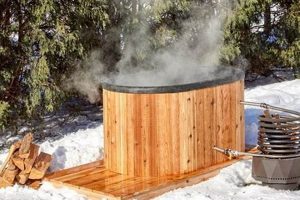
![[DIY Guide] Easy DIY Wood Window Shutters You Can Build! The DIY Hub: Creative Crafts, Repairs & Life Hacks [DIY Guide] Easy DIY Wood Window Shutters You Can Build! | The DIY Hub: Creative Crafts, Repairs & Life Hacks](https://craftingdiycenter.com/wp-content/uploads/2025/07/th-3579-300x200.jpg)
